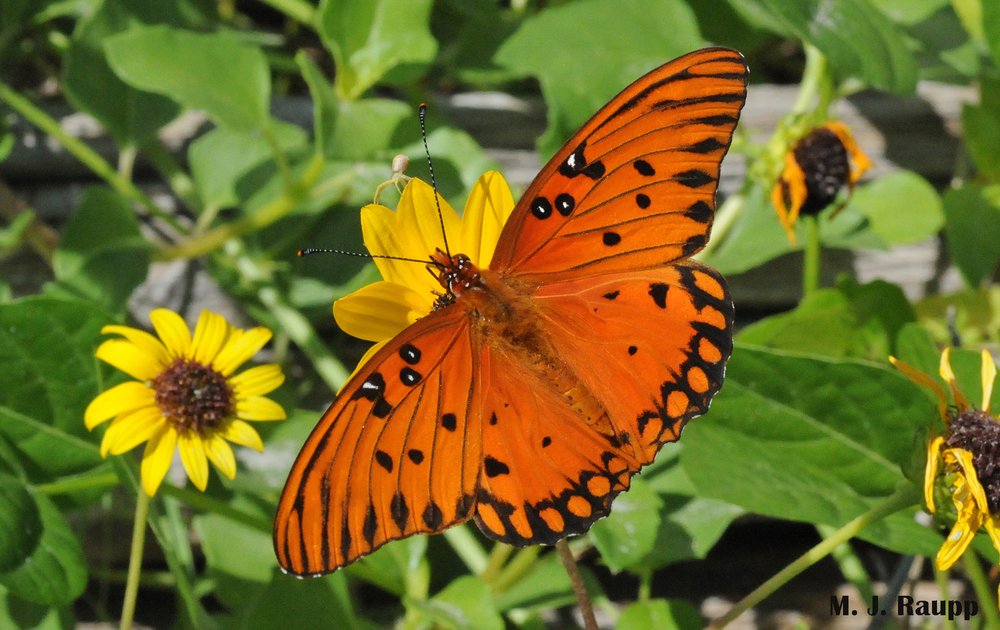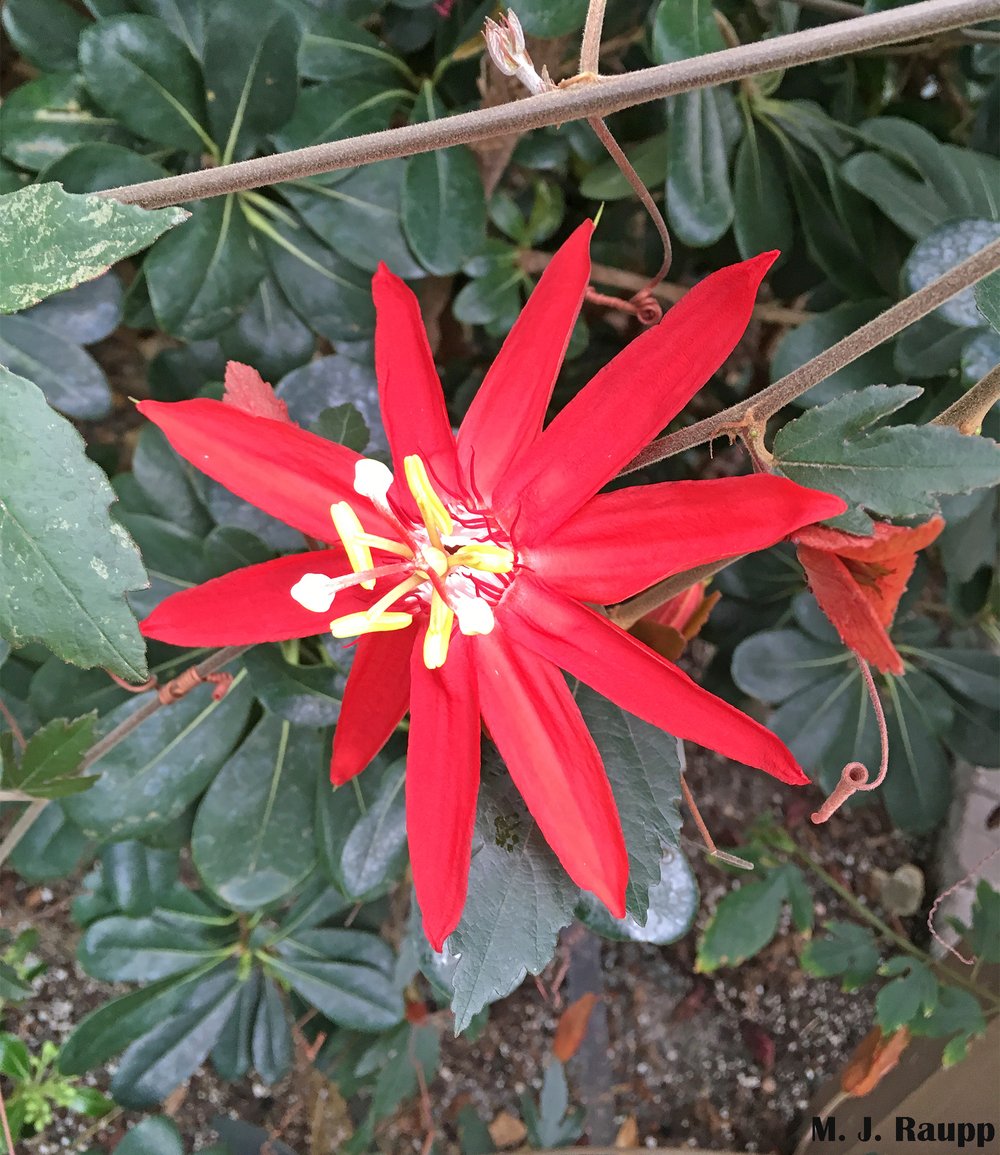Gulf fritillaries wish you a Happy New Year from their new home in Hawai’i: Gulf Fritillary, Agraulis vanillae

The gorgeous Gulf Fritillary butterfly is an exotic visitor welcomed by many on the islands of Hawai’i.
This week Bug of the Week returns to some of the newest land on our planet, the Big Island of Hawai’i, to meet another beautiful immigrant to this tropical paradise. Over the holidays we learned that Monarch butterflies arrived on the Hawaiian Islands sometime after the introduction in the 1800’s of milkweeds, the key food source for their young. Like the Monarch, the Gulf Fritillary is also a super specialist that evolved to utilize members of the passion vine clan, Passiflora spp., as food for its young. When the edible passion fruit yellow granadilla, P. laurifolia, arrived in Hawai’i sometime before 1871, a door was opened for Gulf Fritillaries to colonize the big island and call it home. Records of Hawaiian butterflies prior to 1958 don’t list the Gulf Fritillary, but by 2002 these beauties were recorded on six islands of the Hawaiian archipelago. This broad ranging species takes up permanent residence from Argentina to the southern United States. During summer, peregrinations take it as far north as San Francisco on the west coast and New Jersey on the east coast, but in autumn this vagabond travels south to the warm climes of the Floridian peninsula to spend the winter.

Flowers of the passion vine are among the most magnificent in the plant world but some passion vines are invasive on the Hawaiian Islands.
Like other members of the longwing butterfly clan, larvae of this beauty consume leaves of passion fruit vine. The blossom of the passion fruit vine is one of the most gorgeous in the angiosperm world. Exotic flavors of the passion fruit are used around the world, adding zest to ice cream, cheesecake, and mixed drinks. Passion fruit is rich in vitamin C and lycopene and consuming this delicacy is said to sooth a queasy stomach, according to Andean lore. As a group, passion fruit plants are protected from most leaf-munching caterpillars and other vegan insects by a veritable witch’s brew of highly toxic chemicals including alkaloids, a family of toxins that includes strychnine and nicotine, and cyanogenic glycosides, chemicals that release cyanide upon entering the digestive tract of a caterpillar or human. However, the Gulf Fritillary and other members of its clan, including the zebra longwing we met in a previous episode, turned the tables on passion fruit plants, bypassing the noxious defenses and feasting with impunity on their leaves. Some species of longwings sequester cyanogenic glycosides from their food and others manufacture these compounds on their own, presumably for defense. The striking orange and black coloration of the Gulf fritillary warns vertebrate predators not to mess with this beauty. In addition to any plant derived defenses, the gorgeous Gulf Fritillary has one more bit of chemical trickery to help keep predators at bay. Glands on the abdomen produce and release a concoction of complex esters when the adult butterfly is disturbed. This stinky defensive fluid dissuades predators such as birds from making a meal of these dazzling butterflies.
The introduction of passion vines to Hawaii in the 1800’s opened the door for pretty Gulf Fritillaries to colonize. In their new home butterflies sip nectar from a wide variety of flowering plants. Females deposit eggs on leaves of passion vines and caterpillars consume leaves to obtain nutrients for growth and defensive compounds for protection from predators. Caterpillars often move from vines to pupate and their chrysalises can be found on human-made objects. While some species of passion vines are considered invasive on the Hawaiian Islands, Gulf Fritillaries are gorgeous colonists enjoyed by islanders.
But the beautiful Gulf Fritillary is not all about noxious chemicals and defense. Oh no, observations of mating rituals of these beauties in the Norfolk Botanical Garden some years ago revealed romance afoot where a mating pair of butterflies engaged in a quixotic duet along a footpath. Many male butterflies, including Gulf Fritillaries, have a clever trick for winning the affections of would be mates. At the tip of his abdomen, the Gulf Fritillary has small bristles called hair pencils. The male uses his hair pencils to distribute aphrodisiac pheromones on the antennae of a potential mate. Courtship pheromones are released by the male over the female while both are in flight. These pheromones calm the female’s innate escape response and upon landing the male may hover over the female dusting her with more pheromones. The resulting romantic swoon induced by the pheromone allows the male to approach his mate and, well, shall we say, fulfill the biological imperative of procreation. Beauty, danger, and romance brought to a tropical paradise by airborne voyagers, who could ask for anything more of a butterfly?
Bug of the Week wishes you a joyous New Year!
Acknowledgements
References used in the preparation of this Bug of the Week include ‘Caterpillars of Eastern North America” by David L. Wagner; “Coevolution of Animals and Plants” by Lawrence Gilbert and Peter Raven; “Gulf Fritillary Butterfly, Agraulis vanillae (Linnaeus) (Insecta: Lepidoptera: Nymphalidae)” by Jaret C. Daniels; “Novel chemistry of abdominal defensive glands of nymphalid butterfly Agraulis vanilla” by Gary N. Ross, Henry M. Fales, Helen A. Lloyd, Tappey Jones, Edward A. Sokoloski, Kimberly Marshall-Batty, and Murray S. Blum; “Insects of Hawaii: A Manual of the Insects of the Hawaiian Islands, including an Enumeration of the Species and Notes on their Origin” by Elwood Zimmerman; and “Hawaiian Terrestrial Arthropod Checklist, Fourth Edition” by Gordon M. Nishida. We thank Dr. Dan Gruner for stimulating discussions about the ecology of Hawaiian flora and fauna and Dr. Paula Shrewsbury for images used in this episode.
This post appeared first on Bug of the Week